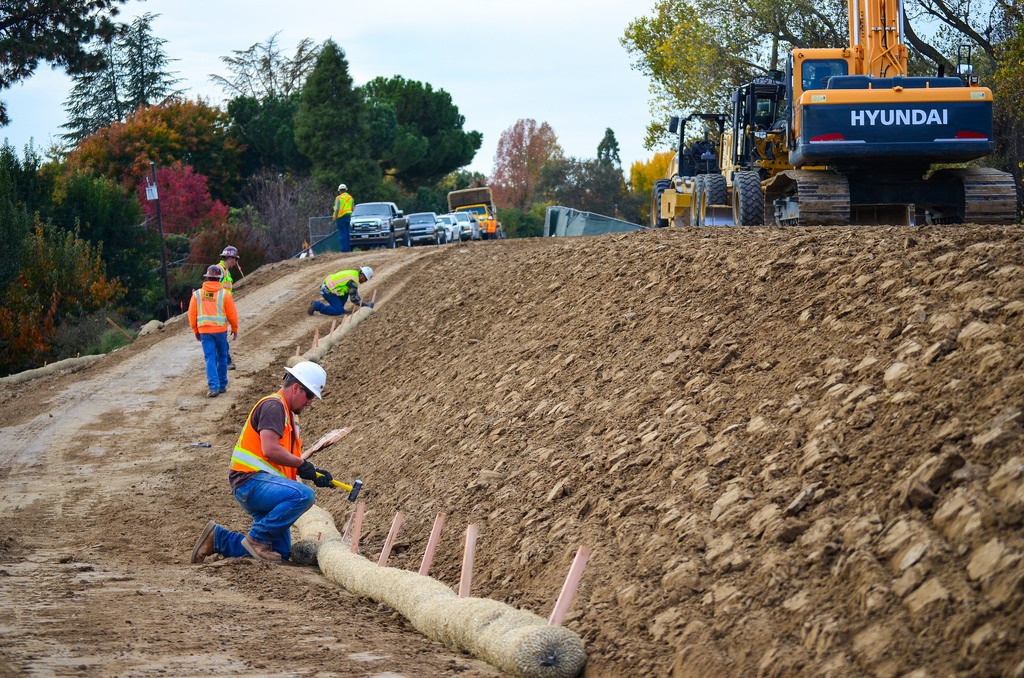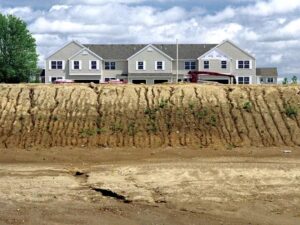Erosion Control:
Safeguarding Your Construction Site and the Environment
At Unified Studio Architect, we understand the pivotal role effective erosion control plays in maintaining not only a safe and sustainable construction site but also in protecting the broader environment. The impact of erosion caused by wind, water, and human activity can be far-reaching, leading to significant environmental damage, construction delays, and potential legal complications. Whether the issue is preventing soil runoff into nearby waterways or protecting neighboring properties from erosion-related damages, a well-planned erosion control strategy is essential for ensuring the success and smooth progress of any construction project.
In this blog post, we’ll explore why proper erosion control is indispensable, outline the potential consequences of inadequate measures, and share the erosion control strategies we implement to mitigate erosion risks. We’ll also delve deeper into the key methods we employ, such as silt fences, sediment basins, erosion control blankets, and more, providing a comprehensive view of how we create a robust plan to protect the environment during construction.
Why Erosion Control Is Essential in Construction Projects

Erosion control is not just a regulatory requirement—it’s an ethical responsibility to safeguard the environment while ensuring the smooth completion of your construction project. Below, we discuss why erosion control is vital:
1. Protects Water Quality
One of the most significant risks associated with construction is the potential contamination of water bodies from soil runoff. During construction activities, the soil is often disturbed, making it prone to erosion. When rainfall or wind washes away this soil, it can end up in nearby rivers, lakes, and streams. This sedimentation can degrade water quality, harm aquatic ecosystems, and violate stringent environmental regulations. Maintaining water quality is critical for protecting wildlife, preventing pollution, and complying with legal standards.
2. Prevents Property Damage
Erosion can cause severe damage to properties, including the foundations of buildings, roads, and landscaping. The continued erosion of soil around a construction site can lead to structural instability, making the site unsafe and hindering further progress. Unchecked erosion can also undermine costly landscaping projects and lead to expensive repairs. These damages not only delay construction timelines but also lead to increased project costs, which can easily be avoided with proper erosion control measures.
3. Complies with Local Regulations
Many municipalities and environmental agencies enforce strict guidelines when it comes to stormwater runoff and soil erosion during construction. These regulations are in place to protect the environment and ensure that construction activities do not harm the surrounding ecosystem. Failing to implement appropriate erosion control measures can result in significant fines, stop-work orders, and even legal challenges that could halt your project. Compliance with these regulations is not optional—it’s a necessity for the successful completion of your project.
4. Reduces Long-Term Environmental Impact
In addition to addressing immediate risks on-site, erosion control helps prevent long-term environmental degradation. By implementing effective erosion control practices, you minimize soil runoff and reduce the impact on the surrounding natural habitats, preserving biodiversity and ensuring that ecosystems remain healthy and sustainable for years to come. This long-term approach is key to promoting sustainable construction practices and reducing the overall environmental footprint of your project.
5. Saves Time and Money
While the initial costs of installing erosion control measures may seem like an added expense, they can actually save significant time and money in the long run. Erosion-related delays, repairs, and cleanup costs can quickly add up, making it essential to invest in proper erosion control strategies early on. By mitigating erosion risks upfront, you can keep the project on track, prevent costly repairs, and reduce the risk of unnecessary fines or penalties.
Common Issues with Inadequate Erosion Control

When erosion control measures are insufficient or poorly implemented, several issues can arise, leading to both environmental and financial consequences:
1. Soil Runoff into Waterways
Without effective erosion control measures, soil runoff from the construction site can flow into nearby water bodies, contaminating them with sediment and pollutants. This can lead to a range of environmental problems, including the destruction of aquatic habitats, blocked drainage systems, and violations of water quality standards. Soil runoff is one of the primary concerns that erosion control aims to address.
2. Loss of Soil Fertility
The loss of fertile topsoil due to erosion can have lasting effects not only on the construction site but also on surrounding areas. Fertile soil is essential for landscaping, planting, and the general health of the ecosystem. Once this soil is washed away, it can be difficult to restore, hindering the completion of landscaping projects and future construction endeavors.
3. Undermined Infrastructure
Erosion has the potential to destabilize critical infrastructure such as foundations, roads, and drainage systems. When water runoff erodes the ground underneath structures, it can cause settling, cracking, or even complete collapse in extreme cases. This can compromise the safety of the site, lead to delays, and increase repair costs.
4. Increased Construction Costs
Inadequate erosion control measures can result in unexpected repairs, increased maintenance, and even fines for non-compliance. The costs of preventing erosion are significantly lower than those associated with fixing the damage it can cause. In addition, project delays caused by uncontrolled erosion can result in a longer construction timeline, increasing overall costs.
How Unified Studio Architect Addresses Erosion Control Challenges
At Unified Studio Architect, we take a proactive approach to erosion control, implementing a range of strategies and solutions to protect the environment and maintain the integrity of our construction sites. Here’s how we address erosion control issues:
1. Silt Fences
Silt fences are one of the most commonly used erosion control measures. These temporary barriers are designed to capture sediment and prevent it from leaving the site, especially during heavy rainfall. Silt fences are strategically placed around the perimeter of the construction site or near areas prone to runoff to trap sediment before it can enter stormwater systems or nearby properties.
- Key Benefits:
- Prevents sediment from flowing into nearby water bodies.
- Cost-effective and easy to install.
- Ideal for small to medium-sized construction sites.
2. Sediment Basins
For larger construction projects, sediment basins are an essential tool in managing water runoff. These basins temporarily store runoff water, allowing sediment to settle before it is released or channeled away from the site. Sediment basins can be designed to handle varying volumes of runoff based on the size and nature of the project.
- Key Benefits:
- Effectively captures and treats stormwater runoff.
- Reduces sediment flow into nearby rivers or lakes.
- Customizable to handle large or complex construction sites.
3. Erosion Control Blankets
Erosion control blankets are ideal for areas with slopes or exposed soil. These blankets help stabilize the soil by preventing erosion and encouraging vegetation growth. Made from natural materials like straw, coconut fiber, or jute, they offer an eco-friendly solution for controlling erosion in less trafficked or active construction areas.
- Key Benefits:
- Protects soil from both wind and water erosion.
- Supports faster establishment of vegetation and root systems.
- Biodegradable and environmentally friendly.
4. Construction-Phase Erosion Control Plans
To ensure consistent erosion control throughout the project, we develop detailed construction-phase erosion control plans. These plans outline specific steps for managing water runoff, controlling erosion, and maintaining best practices during each phase of construction. The plan includes:
- A schedule for monitoring and maintaining erosion control measures.
- Clear guidelines for stormwater runoff management.
- Procedures for responding to unexpected erosion events or adverse weather conditions.
5. Site Preparation and Ongoing Monitoring
Before construction begins, we carefully prepare the site by grading it to ensure proper water flow and direct runoff away from sensitive areas. Additionally, we monitor the site throughout the construction process to ensure that all erosion control measures remain effective. Regular inspections and adjustments are crucial for maintaining site stability and protecting the environment.
6. Vegetative Cover and Mulching
In areas with high erosion risk, we incorporate vegetative cover and mulch to help stabilize the soil. Ground cover acts as a natural barrier against wind and water, while mulch helps retain moisture, suppress weeds, and provide nutrients for plant growth. This dual approach further reduces erosion and promotes healthy vegetation establishment.
Conclusion
At Unified Studio Architect, we are dedicated to creating sustainable and environmentally responsible designs that prioritize erosion control. By implementing a variety of erosion control strategies such as silt fences, sediment basins, erosion control blankets, and comprehensive construction-phase plans, we ensure that your project remains on track while minimizing its environmental impact. Our commitment to sustainability and compliance with local regulations ensures the long-term success of your project, while helping protect the surrounding environment.
If you’re planning a construction project and want to ensure effective erosion control strategies, Unified Studio Architect is here to assist. Contact us today to learn more about how we can help you protect water quality, prevent erosion, and create a construction site that adheres to the highest environmental standards.
